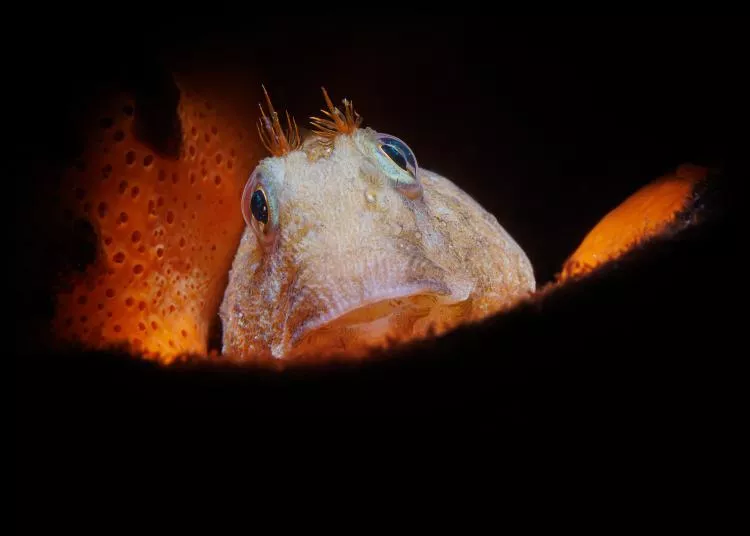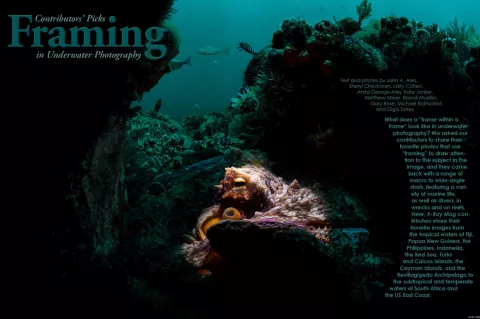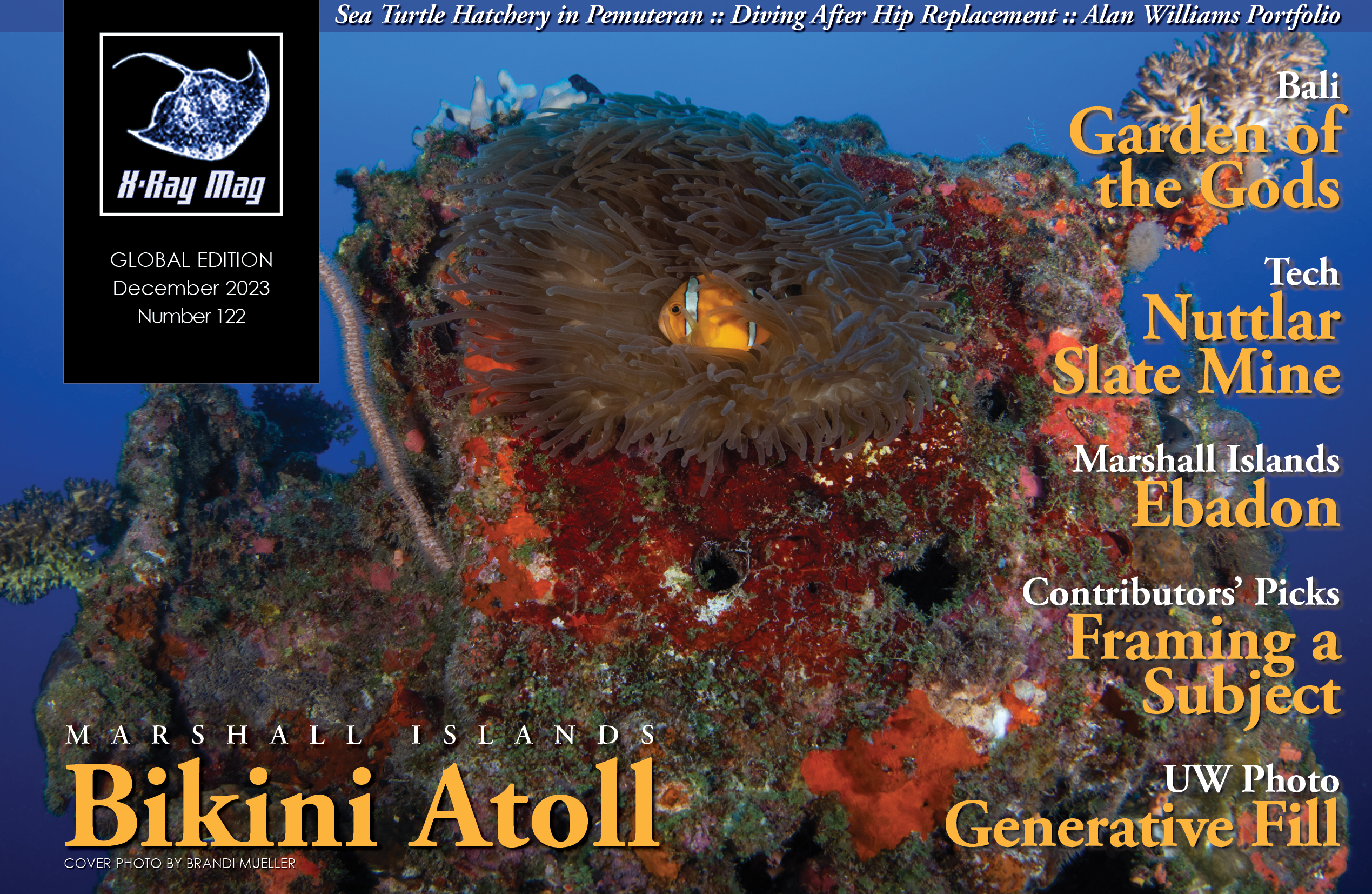What does a “frame within a frame” look like in underwater photography? We asked our contributors to share their favorite photos that use “framing” to draw attention to the subject in the image, and they came back with a range of macro to wide-angle shots, featuring a variety of marine life, as well as divers, in wrecks and on reefs.
Contributed by
(To see all the images in this article, please scroll down to the end and download the pdf.)
Here, X-Ray Magcontributors share their favorite images from the tropical waters of Fiji, Papua New Guinea, the Philippines, Indonesia, the Red Sea, Turks and Caicos Islands, the Cayman Islands, and the Revillagigedo Archipelago to the subtropical and temperate waters of South Africa and the US East Coast.
Framing in UW Photography
Text and photos by Kate Jonker
Framing in underwater photography is an art that can elevate your shots from the ordinary to the extraordinary. In the world beneath the waves, framing can be crafted from various natural underwater elements, creating a sense of balance, and drawing the viewer’s attention to the main subject.
One technique I particularly love is using colours and textures as frames. In underwater photography, the vibrant hues and variety of textures can serve as striking natural frames for your subjects. Imagine your subject framed by a backdrop of contrasting colour.
Framing with light is another great tool. By using a snoot to focus light on your subject while keeping the background in shadow, you make your subject shine as the star of the show.
Even the reef and marine life can play a role in framing. The natural architecture of the underwater world such as the shadow of reefs, the leading lines of sea fans or corals, or tiny nooks and crannies can be utilised to frame your subjects creatively.
For softer foreground framing, you can use swaying kelp, sea fans, soft corals or other marine life. A shallow depth of field can blur the foreground, emphasising your subject.
Mastering the art of framing is a useful technique for creating captivating and memorable underwater images. It is a skill that can be learnt and used to turn an ordinary underwater photo into an extraordinary work of art. Visit: katejonker.com
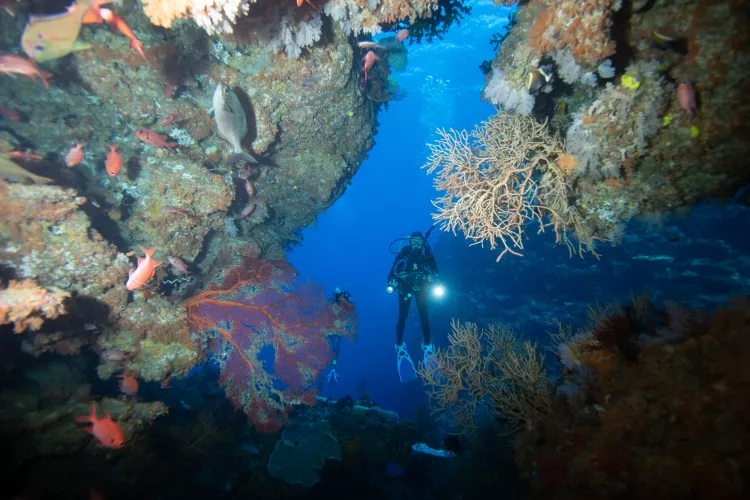
Shipwrecks
Text and photos by John A. Ares
Possibly the two most important aspects of making photographs involves composition and lighting. Framing is an element of composition. Shipwrecks and swim-throughs are natural candidates for “framing.”
In Photo 1, the two divers enhance Fiji’s spectacular corals. The wall is lit by two strobes to highlight the colors of the reef. In Photo 2, two divers approach the wreck of the Dunraven. The Red Sea has many wrecks that have easy penetration, but you must follow a dive guide.
Wrecks are fish magnets. Photo 3 shows a cluster of fish inside the wreck of the Thistlegorm. TheThistlegorm was sunk in WWII by a dive bomber. It is one of the most popular wrecks in the world. The Carnatic wreck (Photo 4) lies on its side and presents multiple perspectives for framing. The view of portholes at the top and crossbeams down below, present a striking colorful design. The two streams of fish provide the last glittering element to add movement to the composition. Visit: JohnAres.com
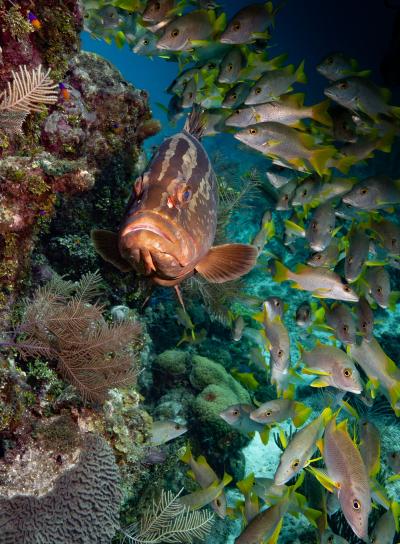
Groupers
Text and photos by Sheryl Checkman
There are many ways that a photographer can draw attention to a subject in a photographic composition. Framing the subject within elements of its environment is one. In nature, and in the underwater realm in particular, this sometimes happens as a happy coincidence, as in the photo of a grouper taken at Great Wall West in Little Cayman (Photo 1). A school of yellow-tail snapper on the right and the reef on the left, naturally frame the grouper, giving no doubt as to what the subject of this composition is.
Another grouper, also shot on the Great Wall West that same day (Photo 2), shows more of a textural framing. The grouper in this shot is positioned in-between the purple sea fan and soft coral Atlantic sea plumes. I chose to convert this shot to black and white in order to highlight how the different textures help to frame the shot.
Another framing technique uses light to separate a subject from a busy background by illuminating the subject and keeping the background dark. In the Turks and Caicos, on a night dive at Cathedral, I photographed another grouper, peering out from a crevasse in the reef (Photo 3). The one strobe that I was using, with my point-and-shoot camera, illuminated both the grouper and the reef on the right, isolating them from the dark background. Visit: Instagram.com/sherylcheckman
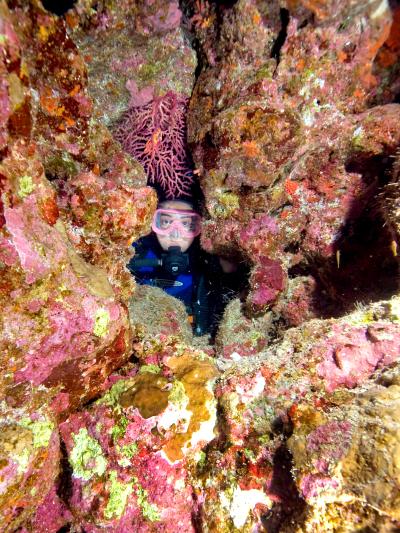
Walls, Arches, Nests and Hideaways
Text and photos by Larry Cohen
I often use a frame around the subject in my photographs, both on land and underwater. The marine environment offers many structures to use as frames when photographing marine life and divers.
When shore diving in Dahab, Egypt, I observed a wall covered with colorful pink growth. I signaled to fellow diver, Renata Rojas, to position herself by the opening in the wall. She wore a pink mask that perfectly matched the environment used as a frame.
The Arch in Papua New Guinea is a magnificent dive site, which I reached via the liveaboard boat Febrina. The massive Arch is covered with sponges and other marine growth. This structure is the perfect frame when photographing a diver.
The liveaboard also visited Widu Harbour. This area has an abundant amount of macro life. I captured an anemonefish framed in a bubble anemone at this location. Anemonefish make their nests in anemones for protection.
At Widu Harbour, I had to pay attention to the small details. I spotted a tiny crab hiding in a sponge. The sponge created a frame, so that in the image, the viewer’s eye is led to the crab. Visit: liquidimagesuw.com
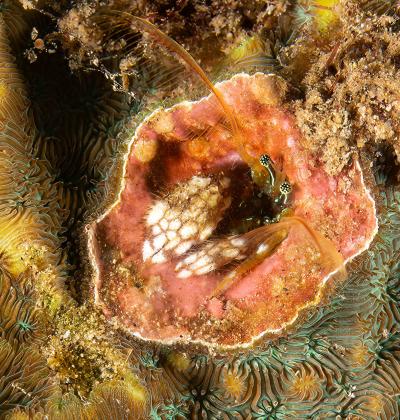
Shapes of Frames
Text and photos by Anita George-Ares, PhD
A blackbar chromis shelters in coral in Photo 1. The branching coral frames the chromis and adds depth and texture to the image. The coral’s warm color complements the warm color of the chromis.
A coral hermit crab remains in its burrow while filtering plankton with its large, feathered antennae (Photo 2). The pink coral creates a wide, elliptical frame around the hermit crab. The white border of the pink coral complements the white markings on the crab’s legs.
The cargo ship Giannis D hit a reef in the Red Sea and sank in 1983. While I was inside the wreck (Photo 3), I came upon a diver shining his light on his gauge and took this image. Although the diver had positioned himself so that he was framed by the open hatch of the wreck, this was a candid shot.
A peacock mantis shrimp guards the entrance of its burrow in Photo 4. The coral fragments create a circular frame around the mantis shrimp. A second frame of dark negative space surrounds the colorful body of the mantis shrimp. The dark negative space provides contrast and depth to the image. Visit: facebook.com/profile.php?id=100016947967639
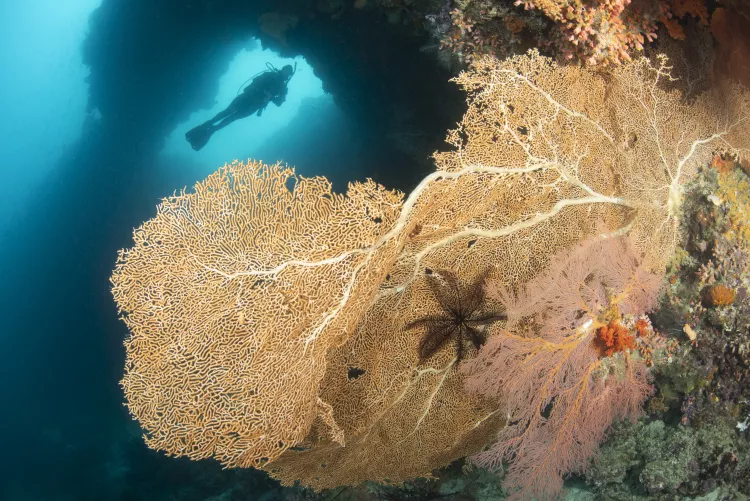
Framing with Structure, Sea Life and Space
Text and photos by Matthew Meier
For this assignment, I selected images in which I literally framed the subject—in this case, my better half and underwater model, Jennifer—by either structure, sea life or negative space, to better highlight the scuba diver in the scene. Framing helps define the composition, and happily, my wife and dive buddy is willing to pose almost anywhere I ask once I discover such backdrops. We have worked on a variety of hand signals, so we can communicate underwater, and she has gotten very good at holding position, even in a stiff current.
Then, it is just a matter of timing my shots to minimize her exhaust bubbles and taking several exposures to be certain I have something that is usable. Not every scenario is productive, and we have certainly swum away from more than a few photo opportunities that ultimately did not work for one reason or another. Here, I present the results of photo shoots that produced successful images. Visit: MatthewMeierphoto.com
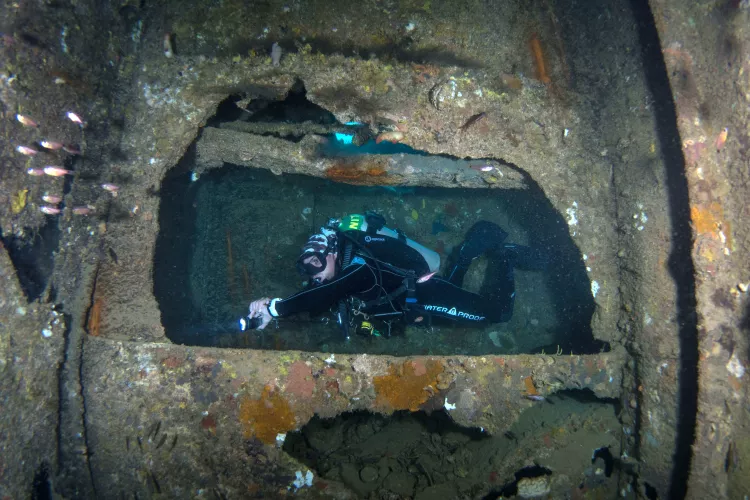
A Photo Within a Photo
Text and photos by Brandi Mueller
Some of my favorite underwater (and topside) images frame the subject, as if the photo is already inside another photo. Wrecks are often full of places where the framing technique can be used. I love to show the contrast of something that used to be above water, which is now in a submerged environment, by showing a diver swimming within it. My intent is to show the viewer that these ships are not where they are supposed to be. Windows, structural beams and machinery can frame divers, as can passageways.
These shots are from the Japanese WWII wrecks that sank in Coron Bay in the Philippines in 1944. They have been underwater for over 75 years, and there are still places on these wrecks that are safe enough to swim through; but as the ocean degrades the wrecks, more areas open up and can be used to frame a diver.
For example, the propeller shaft of the Okikawa Maru has been salvaged, but the tunnel still allows divers to pass through it. Places on the ship where passengers may have walked are now ideal swim-throughs for wreck divers. The wrecks of Coron are a photographer’s dream, with plenty of frames and abundant marine life. Visit: brandiunderwater.com
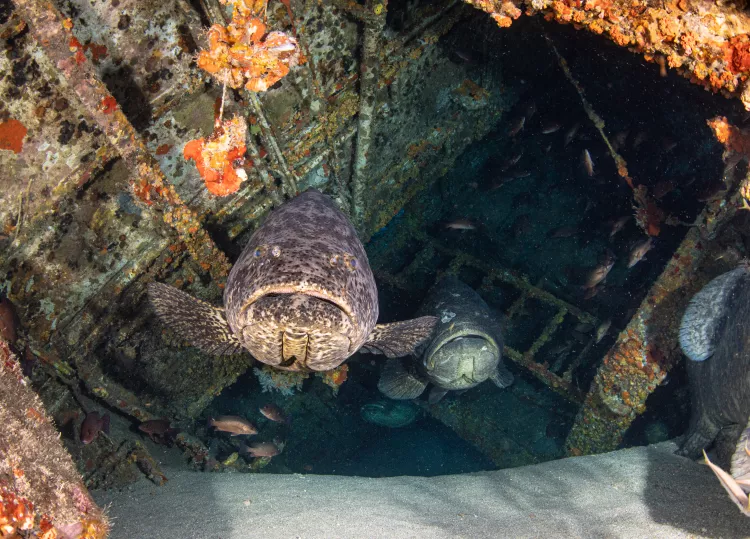
Not Your Usual Framing
Text and photos by Gary Rose, MD
Whenever I go on a photo shoot, I consider many factors to highlight my subject and to draw the viewer to the intention of my capture. In addition to lighting, negative space, rule of thirds, the Fibonacci sequence and the law of inverse proportion, I also like to consider framing, when appropriate.
While diving the Jupiter Wreck Trek in Florida during the annual goliath grouper aggregation (end of August to early September), I came across these huge divas (Photo 1). The tilted angle of the wreck and the sandy bottom created a natural stage for this underwater performance. The unusual polygonal framing balances the disproportionate weight of the left side of the photo. Being aware of your surroundings and recognizing these wonderful setups will greatly augment your photographic armamentarium.
As divers, we almost always look straight ahead and downward. It is important to remind oneself to look up, from time to time. So many wonderful things happen above us. For example, I was able to see this stunning view above me, and capture the brilliant sunburst illuminating a lemon shark—all “framed” by Snell’s window (Photo 2). I also added just a hint of light from my strobes, to eliminate any coarse shadows.
When diving on, and in, shipwrecks, there are many opportunities to frame a subject. Classically, we see another diver, or fish, framed by a porthole or doorway. Photo 3 was shot within the confines of the Hoyt Vandenberg in Key West, Florida. It is the second largest artificial reef in the world. The “Vandy” has 11 floors and is two football fields long. Do not dive inside this wreck without thorough knowledge of its layout, or without a local guide.
In this photo, I decided to break one of the rules of underwater photography: “Do not photograph your subject from the rear, as it swims away.” In the image, the long, narrow, lightless corridor, with a clean sandy bottom, perfectly frames this diver (my son Ryan) and shows off his wreck-diving skill—streamlined, centered, knees bent, with fins high to avoid disturbing silt with a resultant whiteout. It appears as if he is floating in air.
México’s Roca Partida is part of the Revillagigedo Archipelago (240mi southwest of Cabo San Lucas). One of its many amazing geological wonders is that it is a little over 300ft long and 26ft wide and drops off one mile to the ocean floor. It is a veritable aquarium of blue-water, open-ocean life. One of its key attractions are the multiple “cavelets” that pockmark the steep vertical walls of Roca and are almost always occupied by whitetip sharks. The rocky walls and dazzling colorful corals create beautiful and varied framing (Photo 4).
It is challenging to explore framing with a creative eye and go above and beyond the usual portholes, windows and doorways. When diving, seize the opportunity to shut off your logical left brain and open your imaginative right brain. Perhaps, you might even improve your frame of mind while diving. Visit: garyrosephotos.com
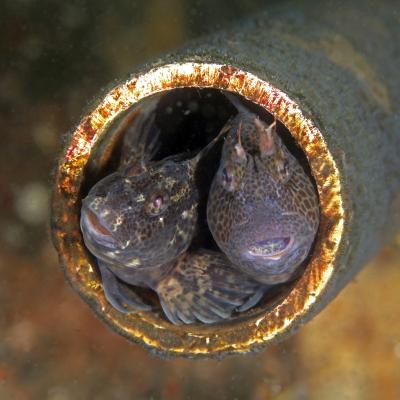
The Process of Surrounding
Text and photos by Michael Rothschild, MD
While the subject is, by definition, the main point in the story that any image is telling, what surrounds the subject can make all the difference. Framing is that process of surrounding—using visual elements and light to draw the viewer’s eye to the subject, or to add to the story by providing context.
The diver in Photo 1 is peeking out of the rusty interior of a shipwreck, with his hands further framing the margins of a possible exit route, pushing away entanglement hazards. The diver in Photo 2 is on the same wreck but not in a confined space. She is outside where the bright green water lit by ambient sunlight makes a nice contrast to a part of the wreck that was once an actual frame around a window. In Photo 3, the exposed ribs of the ship’s hull make the diver look like a bird in a cage, with a long exposure to bring out some detail in the far background. And the two little blennies in Photo 4 have found a cozy home in a piece of cut pipe, which both frames the subjects and protects them from predators. Visit: dive.rothschilddesign.com
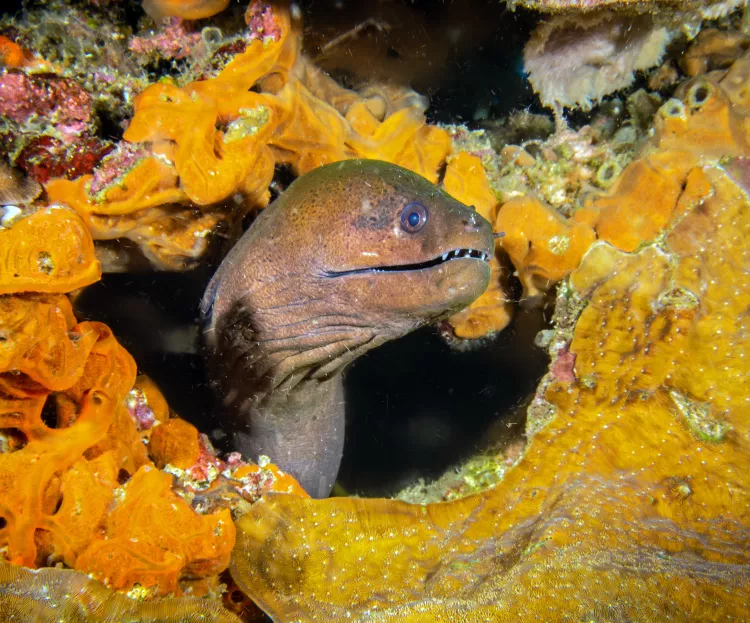
Serendipitous Shots
Text and photos by Olga Torrey
Joelle’s Reef in Kimbe Bay, Papua New Guinea, was formed as an outer-edge sea mount. This dive site was rich in marine life. When I finished my dive there and was swimming toward my dive guide to do a safety stop before surfacing, I noticed a giant moray eel’s head poking out of a soft yellow coral at the mount’s edge. I could not resist turning back and taking a photo. The eel’s face was nicely framed and decorated by the rich texture of the coral (Photo 1).
The Phyllidiella pustulosa nudibranch in Photo 2 entered the yellow sponge through the osculum, a large opening on the outside of a living sponge, which excretes waste. It perfectly framed the oval elongated body of this clustered nudibranch.
The lemon damselfish, Poma-cent-rus moluccensis, in Photo 3 is a small, beautiful fish that can grow up to four inches in length. The fish belongs to a diurnal species, which feeds on algae and planktonic crustaceans. I waited patiently for the camera-shy fish to come out of its coral shelter. To my delight, the fish appeared, framed inside the tiny space, with a curious look on its face. Visit: fitimage.nyc

